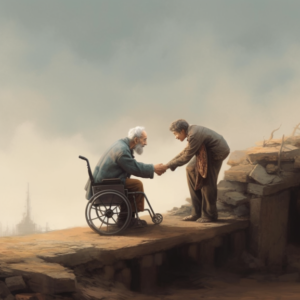Navigating life with a disability often means confronting various forms of discrimination and inequality. Did you know that over 1 billion people in the world experience some form of disability? This blog post will guide you through advocacy strategies and resources to help fight for equal rights for individuals with disabilities.
Let’s create a more inclusive world together!
Key Takeaways
- The Americans with Disabilities Act (ADA) ensures equal rights for people with disabilities in all areas of public life, including employment, government services, accommodations, telecommunications, and transportation.
- People with disabilities face discrimination in various forms such as limited job opportunities and wage earnings, lack of accessibility in public places and educational institutions, and social isolation due to stigma.
- Advocacy strategies for equal rights include recognizing the abilities of individuals with disabilities, actively listening to their input, promoting accessibility in the community, respecting autonomy and self-determination, supporting self-advocacy and self-directions, and fighting against discrimination.
Understanding Disability Rights and Discrimination
Laws and policies exist to protect the rights of people with disabilities, but they still face various forms of discrimination in their daily lives.
Laws and policies protecting the rights of people with disabilities
According to the Americans with Disabilities Act (ADA), people with disabilities have equal rights in all areas of public life. This important piece of legislation prohibits discrimination and ensures that individuals with disabilities have the same opportunities as everyone else to participate in mainstream society.
The ADA covers five major areas: employment, state and local government services, public accommodations, telecommunications, and transportation. Its purpose is to provide a clear mandate for eliminating discrimination against individuals with disabilities and promoting their full participation in society.
Forms of discrimination faced by people with disabilities
People with disabilities often encounter numerous forms of discrimination in their everyday life. They may face bias and prejudice at work, limiting career opportunities and wage earnings.
Accessibility is another vital issue as many public places, including transport systems or buildings fail to include facilities for disabled individuals. In educational institutions, students with disabilities might experience a lack of adequate support and resources tailored to their needs.
Additionally, they frequently deal with social isolation due to stigma and misconceptions about disability. Understanding these discriminatory practices allows us to ensure inclusivity by advocating for equal rights for all people regardless of their abilities.
Advocacy Strategies for Equal Rights
Recognize the individual and their abilities, actively listen and value their input, promote accessibility in the community, respect autonomy and self-determination, support self-advocacy and self-direction, fight against discrimination, and promote inclusivity.
Recognizing the individual and their abilities
People with disabilities bring a unique set of skills and perspectives to the table. Every individual, whether they are living with a disability or not, deserves recognition for their abilities and contributions.
Recognizing their capabilities motivates them to push beyond perceived limitations and engage more actively in opportunities around them. Furthermore, it fosters an environment of respect and equality where everyone feels valued for who they are rather than being defined by what they cannot do.
Recognition plays a pivotal role not only in empowering individuals but also helps in breaking down societal barriers that often restrict people based on misconceptions about disability.
Active listening and valuing their input
Active listening and valuing the input of individuals with disabilities is crucial for effective advocacy. By actively listening, we show respect and acknowledge their unique perspectives and experiences.
This not only allows us to better understand their needs and concerns but also empowers them to play an active role in decision-making processes. When we value their input, we ensure that their voices are heard, validated, and taken into consideration when advocating for equal rights.
It is through active listening and valuing their input that we can truly create inclusive spaces where everyone’s opinions matter.
Promoting accessibility in the community
Promoting accessibility in the community is crucial to ensure equal rights for people with disabilities. Here are some ways we can make our communities more accessible:
- Installing ramps and elevators in public buildings to provide easy access for individuals using wheelchairs or mobility devices.
- Ensuring sidewalks and pathways are wide enough and free from obstructions, allowing individuals with disabilities to navigate safely.
- Implementing accessible parking spaces close to entrances, making it convenient for those with mobility impairments.
- Providing sign language interpreters or captioning services at public events, ensuring effective communication for individuals who are deaf or hard of hearing.
- Offering materials and information in alternate formats, such as Braille or large print, so individuals with visual impairments can access them.
- Creating inclusive playgrounds and recreational areas that cater to children and adults of all abilities.
- Training staff in businesses and establishments on disability awareness, so they can provide appropriate assistance when needed.
- Collaborating with local transportation authorities to improve accessibility on public transportation systems, including buses and trains.

Respecting autonomy and self-determination
Respecting autonomy and self-determination is a crucial aspect of advocating for equal rights for people with disabilities. It means recognizing that individuals with disabilities have the right to make their own choices and decisions about their lives.
It involves actively listening to their voices, valuing their input, and involving them in decision-making processes. By respecting autonomy and self-determination, we empower individuals with disabilities to have control over their own lives and promote independence.
This helps create an inclusive society where everyone’s rights are respected, regardless of disability status.
Supporting self-advocacy and self-direction
Supporting self-advocacy and self-direction is crucial in advocating for equal rights for people with disabilities. It empowers individuals to speak up, make decisions, and take control of their lives. Here are some ways to support self-advocacy and self-direction:
- Encourage individuals to express their needs and desires.
- Provide information and resources to help them make informed choices.
- Respect their decisions, even if they differ from your own opinions.
- Help build confidence by recognizing their strengths and abilities.
- Offer guidance without taking over, allowing them to learn from their own experiences.
- Foster an environment where they feel safe to assert themselves and voice their concerns.
Fighting against discrimination and promoting inclusivity
Promoting inclusivity for people with disabilities is essential for creating an equal and just society. By fighting against discrimination and advocating for their rights, we can work towards ensuring that individuals with disabilities have the same opportunities and access to resources as everyone else. This includes actively challenging ableism and working to eliminate barriers that prevent full participation in all aspects of life. Some strategies for fighting discrimination and promoting inclusivity include:
- Educating others: Raising awareness about disability rights and challenging negative stereotypes can help combat discrimination. Through education, we can encourage a more inclusive mindset among individuals, organizations, and communities.
- Advocacy for policy change: Supporting legislation that protects the rights of people with disabilities is crucial. This includes advocating for accessible transportation, housing, healthcare, employment opportunities, and government services.
- Creating inclusive environments: Promoting accessibility in public spaces, such as ramps, elevators, and braille signage, ensures that individuals with disabilities can fully participate in society. Providing assistive technologies or reasonable accommodations also helps create an inclusive environment.
- Amplifying voices: Listening to individuals with disabilities and valuing their input is essential in advocating for their rights. Centering their experiences allows us to better understand the challenges they face and develop effective solutions.
- Fighting ableism: Challenging ableist attitudes and assumptions helps break down barriers to inclusion. It involves recognizing the value of diverse abilities and reframing disability as a natural part of human diversity rather than a limitation.

- Promoting employment opportunities: Encouraging businesses to hire individuals with disabilities promotes inclusivity in the workplace. Offering training programs or creating supportive work environments can increase job opportunities for people with disabilities.
- Supporting inclusive education: Ensuring that students with disabilities have access to quality education alongside their peers without disabilities fosters inclusivity from an early age.
Resources and Organizations for Disability Advocacy
Local and national organizations play a crucial role in empowering individuals with disabilities and promoting equal rights, such as advocacy groups that focus on independent living and support networks for disability rights.
Local and national organizations empowering individuals with disabilities
Local and national organizations are working tirelessly to empower individuals with disabilities. They provide support, resources, and advocacy to ensure equal rights and opportunities for people with disabilities. These organizations play a crucial role in promoting inclusivity and fighting against discrimination. Some of the notable organizations include:
- American Association of People with Disabilities (AAPD): AAPD works towards advancing the inclusion of people with disabilities in all aspects of society through advocacy, public policy, and disability rights initiatives.
- National Disability Rights Network (NDRN): NDRN is a nonprofit organization that promotes and protects the rights of individuals with disabilities by supporting legal advocacy, investigating abuse or neglect cases, and providing training on disability-related issues.
- Disabled Sports USA: This organization aims to improve the lives of people with disabilities through sports by providing adaptive sports opportunities, training programs, and support for athletes across the nation.
- National Council on Independent Living (NCIL): NCIL is composed of local independent living centers that promote independent living and advocate for the full integration of individuals with disabilities into their communities.
- Autism Society: The Autism Society provides support services, resources, and advocacy for individuals on the autism spectrum and their families to improve their quality of life.
- Special Olympics: Special Olympics offers year-round sports training and athletic competitions for children and adults with intellectual disabilities, promoting inclusion, self-confidence, and empowerment.

Advocacy groups promoting independent living
Advocacy groups play a crucial role in promoting independent living for individuals with disabilities. These organizations provide support and resources to help people with disabilities lead fulfilling lives. They work towards creating inclusive communities and advocating for equal access to education, employment, and government services. Through their efforts, advocacy groups empower individuals with disabilities to live independently and be active participants in society. They also collaborate with policymakers and community leaders to bring about positive changes that promote inclusivity and equality for all. Some prominent advocacy groups include:
- The National Council on Independent Living (NCIL): NCIL is a cross-disability organization that advocates for the rights of individuals with disabilities to live independently and fully participate in all aspects of society.
- American Association of People with Disabilities (AAPD): AAPD is the largest nonprofit organization in the United States dedicated to ensuring full political, economic, and social inclusion of individuals with disabilities.

- Disability Rights Education & Defense Fund (DREDF): DREDF works to advance the civil rights of individuals with disabilities through litigation, legislation, advocacy, and education.
- The Arc: The Arc promotes and protects the human rights of individuals with intellectual and developmental disabilities through advocacy efforts at the local, state, and national levels.
- National Disability Rights Network (NDRN): NDRN is a network of protection and advocacy agencies that advocate for the rights of individuals with disabilities at both federal and state levels.
- Centers for Independent Living (CILs): CILs are community-based organizations that provide resources, support services, skills training, and advocacy to maximize independence for individuals with disabilities.
- Self Advocates Becoming Empowered (SABE): SABE is a national self-advocacy organization run by people with intellectual or developmental disabilities who promote self-determination and inclusion.
Support networks for disability rights
Support networks for disability rights provide valuable resources and assistance to individuals with disabilities. These networks aim to empower and advocate for equal rights for people with disabilities. Here are some examples of support networks:
- Disability Rights Education & Defense Fund (DREDF): This national nonprofit organization works to advance the civil rights of individuals with disabilities through legal advocacy, education, and public policy reform.
- Independent Living Centers: These centers provide a wide range of services and support to help individuals with disabilities live independently. They offer resources such as peer counseling, assistive technology, and advocacy training.
- The Arc: As the largest national community-based organization advocating for people with intellectual and developmental disabilities, The Arc strives to promote inclusion and fight against discrimination. They offer support services like employment programs, housing assistance, and educational opportunities.
- National Council on Independent Living (NCIL): NCIL is a grassroots organization that promotes independent living for individuals with disabilities. It focuses on issues such as accessibility, transportation, employment, and community integration.
- Family Support Network: These networks connect families of individuals with disabilities to each other for emotional support and information sharing. They often host events, workshops, and online forums where families can connect.

- Statewide Advocacy Organizations: Many states have their own organizations dedicated to disability advocacy. These groups work closely with local communities to address specific concerns faced by individuals with disabilities.
Impact of Advocacy and Empowering Stories
Learn how advocacy efforts and empowering stories have brought about positive changes in policy, society, and the lives of individuals with disabilities. Discover inspiring examples of inclusive practices, accessible environments, and the transformative power of advocating for equal rights.
Read More!
Stories of individuals successfully advocating for their rights
People with disabilities have been making significant strides in advocating for their rights. These inspiring stories highlight how individuals have overcome challenges and fought for equality.
Take, for example, the story of Jane Doe, who tirelessly campaigned for accessible transportation in her community. Through her advocacy efforts, she successfully secured funding to improve public transportation options for people with disabilities.
Another success story is John Smith, who challenged discriminatory employment practices by filing a lawsuit against a company that denied him a job solely based on his disability. His case not only resulted in him being hired but also paved the way for changes in hiring practices across industries.
Positive changes in policy and society through advocacy efforts
Advocacy efforts have led to significant positive changes in both policy and society for people with disabilities. Laws and regulations have been implemented to protect their rights, ensuring equal access to employment, government services, and civil rights.
Society has become more inclusive by promoting accessibility and accommodating the needs of individuals with disabilities. Discrimination is being fought against, as inclusivity becomes a priority.
As a result of these advocacy efforts, individuals with disabilities are experiencing greater empowerment, equality, and social justice in their daily lives.
Examples of inclusive practices and accessible environments
Inclusive practices and accessible environments promote equal rights and opportunities for people with disabilities. They ensure that individuals with disabilities can fully participate in all aspects of society. Here are examples of inclusive practices and accessible environments:
- Building ramps and installing elevators to make buildings wheelchair accessible.
- Providing braille signage and audio descriptions for individuals with visual impairments.
- Offering captioning services for deaf or hard-of-hearing individuals during presentations or events.
- Implementing flexible work arrangements to accommodate individuals with disabilities.
- Creating inclusive educational settings by providing assistive technologies and specialized support.
- Developing accessible websites that meet web accessibility standards, such as using alt text for images.

- Designing transportation systems with accessibility features like wheelchair lifts on buses or trains.
- Ensuring that public spaces have designated parking spots for people with disabilities.
- Promoting disability awareness through training programs and workshops in schools and workplaces.
- Encouraging businesses to hire individuals with disabilities by offering tax incentives or grants.
Conclusion: Creating a Better World for People with Disabilities
Advocating for equal rights for people with disabilities is crucial in creating a better world. By fighting against discrimination, promoting inclusivity, and supporting self-advocacy, we can ensure that individuals with disabilities are empowered to live their lives fully and participate in society on an equal footing.
Together, let’s work towards a more inclusive and accessible future for all.
